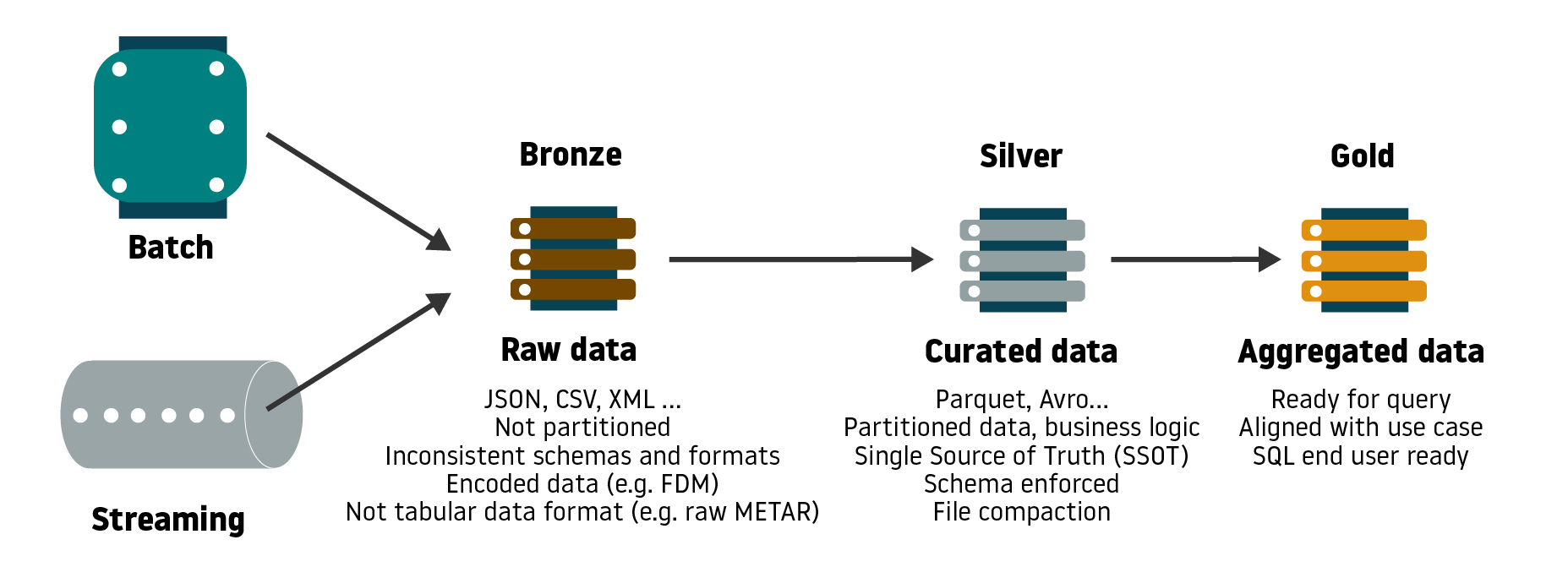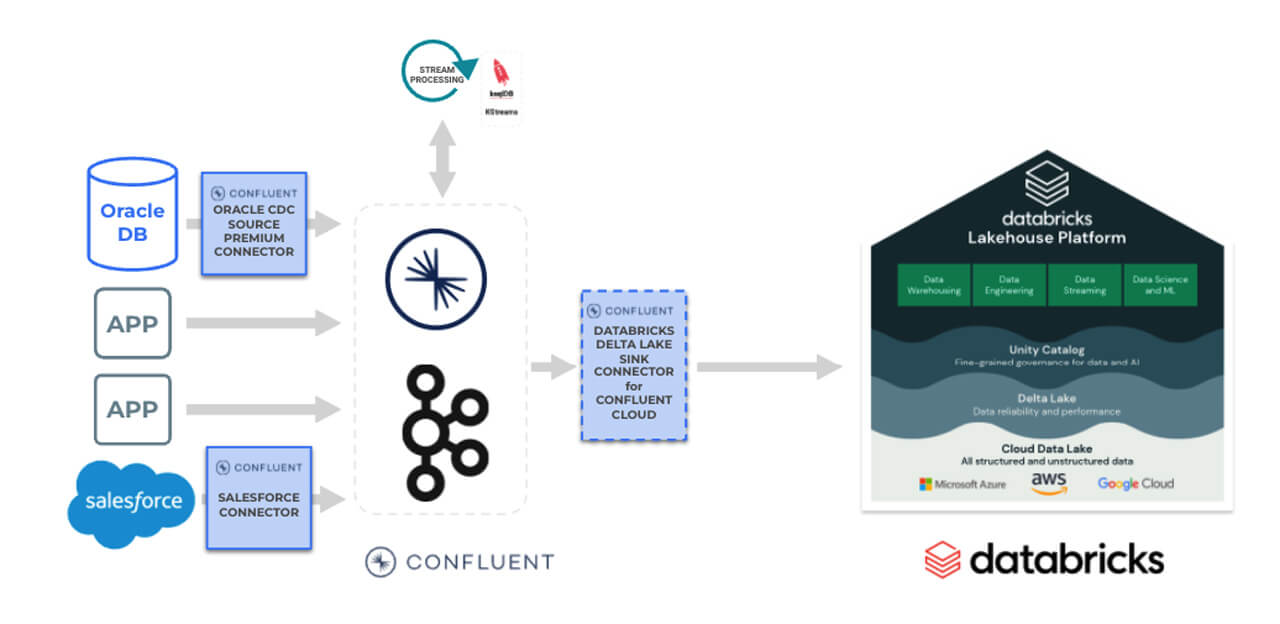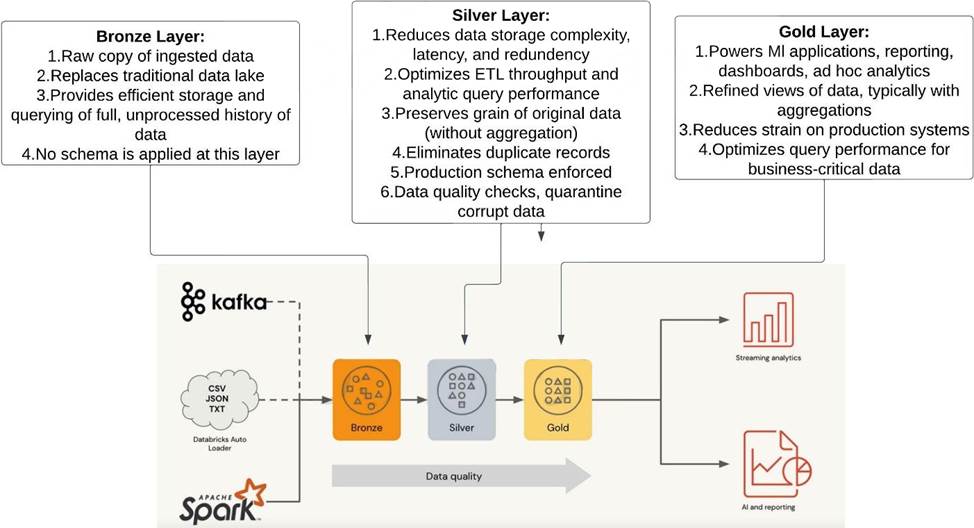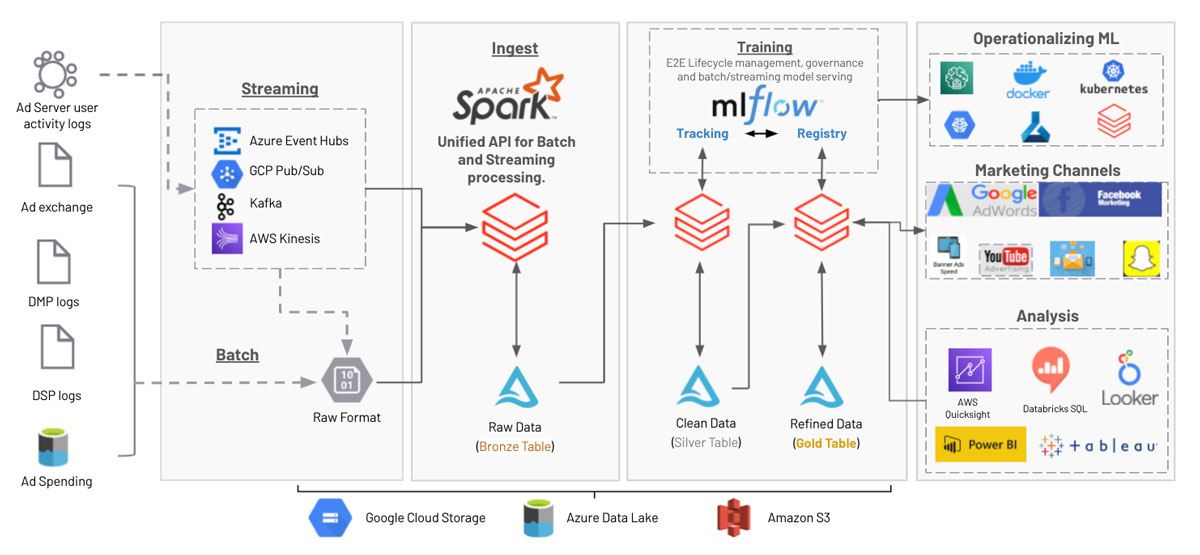What is Medallion Architecture and Why is it Important?
Medallion Architecture is a data lake design pattern that is used to efficiently manage and analyze large volumes of data. This approach was developed by Databricks and is based on the concept of creating multiple layers of data, each with a specific purpose. The three layers of Medallion Architecture are Bronze, Silver, and Gold, and they work together to create a scalable and maintainable data lake.
The Bronze layer is the raw data layer, where data is ingested from various sources and stored in its original format. The Silver layer is the cleaned and transformed data layer, where data is processed and prepared for analysis. The Gold layer is the curated data layer, where data is organized and optimized for querying and reporting.
Implementing Medallion Architecture in Databricks can provide numerous benefits for organizations, including improved data quality, faster query times, and easier maintenance. By separating raw data from processed data, organizations can ensure that their data is accurate, consistent, and up-to-date. Additionally, by optimizing data for querying and reporting, organizations can reduce the time and resources required to analyze their data.
Medallion Architecture is an important concept for organizations that are looking to get the most out of their data. By implementing this approach, organizations can create a scalable and maintainable data lake that can handle large volumes of data and provide valuable insights for decision-making.
The Three Layers of Medallion Architecture: Bronze, Silver, and Gold
Medallion Architecture is a data lake design pattern that is implemented in Databricks using three layers: Bronze, Silver, and Gold. Each layer has a specific role in the data pipeline and they work together to create a scalable and maintainable data lake.
Bronze Layer: Raw Data Ingestion
The Bronze layer is the raw data layer, where data is ingested from various sources and stored in its original format. This layer is responsible for collecting and storing raw data from various sources, such as log files, databases, and APIs. The data in this layer is not processed or transformed in any way, it is simply stored in its raw form for future use.
Silver Layer: Cleaned and Transformed Data
The Silver layer is the cleaned and transformed data layer, where data is processed and prepared for analysis. This layer is responsible for cleaning, transforming, and enriching the raw data from the Bronze layer. The data in this layer is processed using tools such as Spark, PySpark, or Databricks SQL, and is transformed into a format that is suitable for analysis.
Gold Layer: Curated Data for Querying and Reporting
The Gold layer is the curated data layer, where data is organized and optimized for querying and reporting. This layer is responsible for creating tables, views, and other data structures that are optimized for querying and reporting. The data in this layer is optimized for performance, and is designed to provide fast and efficient access to the data that is needed for analysis.
How the Layers Work Together
The three layers of Medallion Architecture work together to create a scalable and maintainable data lake. The Bronze layer provides a source of raw data that can be used for analysis, while the Silver layer provides a cleaned and transformed version of the data that is suitable for analysis. The Gold layer provides a curated version of the data that is optimized for querying and reporting. By separating raw data from processed data, organizations can ensure that their data is accurate, consistent, and up-to-date, and can reduce the time and resources required to analyze their data.
A Practical Example: Implementing Medallion Architecture in Databricks
In this section, we will provide a step-by-step example of how to implement Medallion Architecture in Databricks. This example will demonstrate how to ingest raw data from a CSV file, clean and transform the data, and create a curated version of the data for querying and reporting.
Step 1: Create a Bronze Table
The first step is to create a Bronze table in Databricks to store the raw data. This can be done by creating a new table in Databricks and loading the data from a CSV file. The following code snippet shows how to create a Bronze table in Databricks:
%sql CREATE TABLE bronze.raw_data USING CSV OPTIONS (header 'true', inferSchema 'true') LOCATION '/mnt/data/raw_data'; Step 2: Clean and Transform the Data
The next step is to clean and transform the data in the Bronze table. This can be done using tools such as Spark, PySpark, or Databricks SQL. The following code snippet shows how to clean and transform the data in Databricks:
%python from pyspark.sql import functions as F df = spark.table('bronze.raw_data')
df = df.withColumn('column1', F.col('column1').cast('string'))
df = df.withColumn('column2', F.col('column2').cast('integer'))
df = df.filter(F.col('column3') != '')
silver_df = df.write.mode('overwrite').saveAsTable('silver.cleaned_data')
Step 3: Create a Gold Table
The final step is to create a Gold table in Databricks to store the curated data. This can be done by creating a new table in Databricks and loading the data from the Silver table. The following code snippet shows how to create a Gold table in Databricks:
%sql CREATE TABLE gold.curated_data AS SELECT * FROM silver.cleaned_data DISTINCT; By following these steps, organizations can implement Medallion Architecture in Databricks and efficiently manage and analyze large volumes of data. This approach provides a scalable and maintainable data lake that can be used for querying and reporting, and can help organizations reduce the time and resources required to analyze their data.
Benefits of Using Medallion Architecture in Databricks
Medallion Architecture provides several benefits for organizations that are looking to efficiently manage and analyze large volumes of data. Some of the key benefits include:
- Improved data quality: By implementing a multi-layer data pipeline, organizations can ensure that their data is accurate, consistent, and up-to-date. This can help organizations make better decisions and avoid costly mistakes.
- Faster query times: Medallion Architecture is designed to optimize query performance, which can help organizations reduce the time and resources required to analyze their data. This can lead to faster decision-making and improved productivity.
- Easier maintenance: By separating raw data from processed data, organizations can simplify their data pipelines and make it easier to maintain their data infrastructure. This can help organizations reduce the time and resources required to manage their data.
These benefits can translate into real-world cost savings and productivity improvements for organizations. For example, by reducing the time and resources required to analyze data, organizations can free up resources to focus on other tasks. Additionally, by improving data quality, organizations can make better decisions and avoid costly mistakes.
Medallion Architecture is a powerful approach for managing and analyzing large volumes of data. By implementing this architecture in Databricks, organizations can take advantage of these benefits and improve their data management and analysis capabilities.
Challenges and Best Practices for Implementing Medallion Architecture in Databricks
Implementing Medallion Architecture in Databricks can be a complex process, and organizations may face several challenges along the way. Some of the common challenges include:
- Data governance: Ensuring that data is accurate, consistent, and up-to-date can be a challenge, especially in large organizations with complex data ecosystems.
- Testing: Testing data pipelines can be time-consuming and resource-intensive, and organizations may struggle to ensure that their data pipelines are working as intended.
- Monitoring: Monitoring data pipelines to ensure that they are running smoothly and efficiently can be a challenge, especially in large organizations with complex data ecosystems.
To overcome these challenges, organizations should follow best practices for implementing Medallion Architecture in Databricks. These best practices include:
- Establishing data governance policies: Organizations should establish clear data governance policies to ensure that data is accurate, consistent, and up-to-date. This can include processes for data validation, data cleansing, and data enrichment.
- Testing data pipelines: Organizations should test their data pipelines thoroughly to ensure that they are working as intended. This can include unit testing, integration testing, and end-to-end testing.
- Monitoring data pipelines: Organizations should monitor their data pipelines to ensure that they are running smoothly and efficiently. This can include monitoring data quality, data volume, and data velocity.
By following these best practices, organizations can ensure the success of their Medallion Architecture implementations in Databricks. Data governance, testing, and monitoring are critical components of a successful Medallion Architecture implementation, and organizations should prioritize these activities to get the most out of their data.
Real-World Use Cases of Medallion Architecture in Databricks
Medallion Architecture has been successfully implemented in a variety of organizations to solve real-world business problems. Here are a few examples:
Example 1: Improving Data Quality for a Retail Organization
A retail organization was struggling with data quality issues in their data lake. Data was scattered across multiple tables, and it was difficult to ensure that the data was accurate, consistent, and up-to-date. By implementing Medallion Architecture in Databricks, the organization was able to create a scalable and maintainable data lake with clear data governance policies. This resulted in improved data quality, faster query times, and easier maintenance.
Example 2: Streamlining Data Pipelines for a Healthcare Organization
A healthcare organization was struggling with complex data pipelines that were difficult to manage and maintain. By implementing Medallion Architecture in Databricks, the organization was able to streamline their data pipelines and reduce the time and resources required to manage and maintain their data. This resulted in faster query times, improved data quality, and easier maintenance.
Example 3: Enabling Real-Time Data Analysis for a Financial Services Organization
A financial services organization was looking to enable real-time data analysis for their business users. By implementing Medallion Architecture in Databricks, the organization was able to create a scalable and maintainable data lake that supported real-time data analysis. This resulted in improved data quality, faster query times, and easier maintenance.
These examples demonstrate the power of Medallion Architecture in Databricks for solving real-world business problems. By implementing this architecture, organizations can improve their data management and analysis capabilities, and unlock new insights and opportunities for their business.
Comparing Medallion Architecture to Other Data Lake Designs
Medallion Architecture is just one approach to data lake design. Here’s how it compares to other popular approaches:
Data Warehouse
A data warehouse is a centralized repository of data that is optimized for reporting and analysis. Data is extracted from various sources, transformed, and loaded into the data warehouse. Medallion Architecture and data warehouses share some similarities, such as the use of multiple layers to manage data. However, data warehouses are typically optimized for structured data, while Medallion Architecture is designed to handle both structured and unstructured data.
Data Lakehouse
A data lakehouse is a new approach to data management that combines the best features of data lakes and data warehouses. Like a data lake, a data lakehouse can handle both structured and unstructured data. Like a data warehouse, a data lakehouse is optimized for reporting and analysis. Medallion Architecture can be used in a data lakehouse to manage data, but it is not a requirement.
When to Use Medallion Architecture
Medallion Architecture is best suited for organizations that need to manage large volumes of data, including both structured and unstructured data. It is also well-suited for organizations that need to support real-time data analysis and machine learning. However, it may not be the best approach for organizations with simple data management needs or for organizations that are not yet ready to invest in a full data lake implementation.
When considering a data lake design, it’s important to evaluate the specific needs of your organization and choose the approach that best meets those needs. Medallion Architecture is just one option to consider, but it can be a powerful tool for organizations that need to manage and analyze large volumes of data.
The Future of Medallion Architecture in Databricks
Medallion Architecture has proven to be a powerful tool for organizations looking to efficiently manage and analyze large volumes of data. As data continues to grow in volume and complexity, it’s likely that Medallion Architecture will continue to evolve to meet these changing needs.
Emerging Trends and Technologies
One trend that is likely to impact the future of Medallion Architecture is the increasing use of real-time data. With the rise of IoT devices and other real-time data sources, organizations are looking for ways to process and analyze data in real-time. Medallion Architecture is well-suited to this task, as it is designed to handle large volumes of data in real-time.
Another trend that is likely to impact Medallion Architecture is the increasing use of machine learning. As machine learning becomes more prevalent, organizations are looking for ways to integrate machine learning into their data pipelines. Medallion Architecture can be used to manage the data used for machine learning, making it easier to train and deploy machine learning models.
Best Practices for Staying Up-to-Date
To stay up-to-date with the latest trends and technologies in Medallion Architecture, organizations should follow best practices such as:
- Regularly attending industry conferences and events
- Participating in online communities and forums
- Reading industry publications and blogs
- Collaborating with other organizations and experts in the field
By staying up-to-date with the latest trends and technologies, organizations can continue to get the most out of their Medallion Architecture implementations and stay ahead of the competition.








